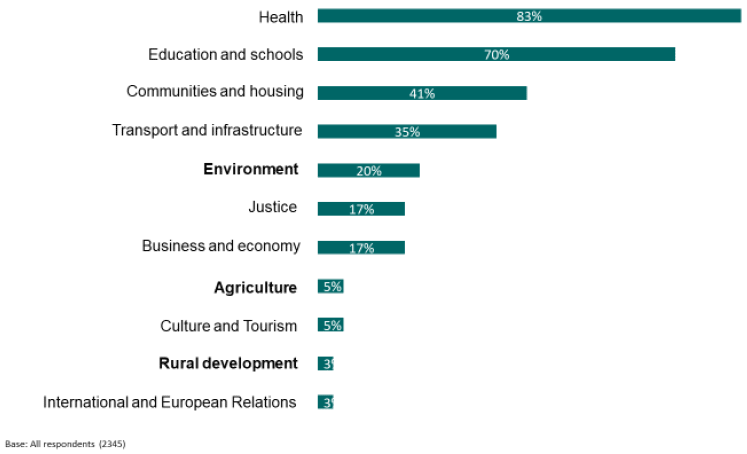Citizens' forums, and attitudes to agriculture, environment and rural priorities: research report
Results of an independent study into Scottish public attitudes to the environment, agriculture and rural development.
Raising the profile of the sector
There was a view that a guiding principle of future policy should be to raise the profile of the agricultural sector among the public as well as increase awareness of the scope of the sector covering food production, environmental protection, land management and supporting rural communities. Indeed the research shows that prima facie the linkages and relationships between these various aspects of the policy are not clear so there is scope for public awareness of the role of the agricultural sector and the wider issues affecting those living in rural communities.
Current profile of the sector
To help situate the relative importance of each of the three key aspects of the CAP including agriculture, environment and rural development, respondents to the survey were invited to indicate the top three government portfolios that should be prioritised in terms of government spending.
Pertinently, 5% prioritised agriculture relative to a range of government portfolios, a fifth (20%) prioritised the environment, and a small proportion (3%) of the sample prioritised rural development (3%).
Figure 7.1. Relative importance of a range of government portfolios

Younger people were more likely than those in older age groups to cite the environment as a priority for government spending (29% among those aged 16-34 comparative to 16% among 45-54; 17% among 55-64; and 15% among 65+).
Agriculture and rural development were attributed higher importance among those in accessible rural and remote rural locations than those in urban areas and small towns.
Table 7.1: Agriculture and rural development priority for government spending by 6-fold urban-rural classification
| Overall % | Remote rural % | Accessible rural % | Remote small towns % | Acessible small towns % | Other urban areas % | Large urban areas % | |
|---|---|---|---|---|---|---|---|
| Agriculture | 5 | 14 | 8 | 8 | 4 | 3 | 4 |
| Rural development | 3 | 12 | 7 | 6 | 6 | 1 | 2 |
Another important variation in the results is in relation to the priority attributed to business and economy in terms of government spending among those in remote rural locations comparative to all other location breakdowns by the six-fold classification (32% in remote rural compared to 15% accessible rural; 17% remote small towns; 9% accessible small towns; 15% other urban areas; and 18% large urban areas).
Qualitative research identified the issue of workforce sustainability for Scottish agriculture, which is another important consideration given the low profile of the sector among other government portfolios. There was a recognition that young people do not consider farming as a desirable profession which will in turn affect new entrants to the industry and will lead to labour issues.
"The newer generation don't want to get up at 5am and get their hands dirty working the land; they are frightened of hard work" (Interview participant)
Reflecting the discussions about workforce, there was also mention of education provision in farming and agriculture to encourage new entrants but also to develop the skills of the existing workforce. Research undertaken by the James Hutton Institute[22] for the Scottish Land Commission has identified that women and new entrants to the agricultural sector may be key to modernising and driving improvements to the sector as they offer entrepreneurialism, and a different knowledge and skill set from their previous education and employment backgrounds. This is pertinent as the 2018 agricultural census has shown that only 17% of farm and croft occupiers are female[23]; and Scottish Government's research into women in agriculture has highlighted that the cultural practice of passing on large farms intact to farmers' sons inhibits new entrants to the sector[24].
Furthermore, while there is an acknowledgement that those with real knowledge of the sector should make decisions about the future shape of agriculture policy, there is appetite for more information provision which is possible through a deliberative engagement model to ensure that the public are informed about the policy and have an opportunity to feed into decision-making.
Points of consideration:
- There is a need to raise the profile of the sector and make the public aware of the scope of agriculture policy - particularly in relation to protecting and conserving the environment which is prioritised 4 times over agriculture in terms of the funding of government portfolios (20% compared with 5%).
- Raising the profile of the sector can be done with the aim of attracting new entrants to the sector, particularly as new entrants can help support the future sustainability of the workforce but also drive improvements and help to modernise the sector;
- While, there is a view that those with knowledge and expertise of the sector should be responsible for making decisions about the direction of future policy, widening public knowledge and awareness of the sector can help build confidence in feeding into decision-making processes.
Contact
There is a problem
Thanks for your feedback